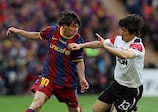2010/11 technical report examines state of play
lundi 26 septembre 2011
Résumé de l'article
The official UEFA Champions League technical report looks at tactical and technical trends from last season's competition and throws up talking points for coaches and fans alike.
Contenu médias de l'article

Corps de l'article
The UEFA Champions League remains the premium club competition – and its technical and tactical trends provide considerable food for thought for Europe's leading technicians. The reflections and analyses of a select group of them give a fascinating insight into the 2010/11 season in the latest official UEFA Champions League technical report.
The report is compiled by a team of experienced coaches and observers. It focuses not only on the tactical and technical trends from last season, but also throws up a variety of interesting talking points that aim to stimulate debate about the UEFA Champions League.
"In addition to factual and statistical data, [the report] contains analysis, reflections and debating points which, it is hoped, will give technicians food for thought and, by highlighting tendencies and trends at the peak of professional football, also offer coaches who are active in the development levels of the game information that may be helpful in terms of working on the qualities which will be needed by the UEFA Champions League performers of the future," the report states.
The report will also interest the lay football enthusiast who follows the action either in the stadium or on the television screen. The exploits of champions FC Barcelona amid a golden era for Spanish football receive justified praise, but are nevertheless seen as part of a high-quality whole. "The Spanish national team in 2008 and 2010 and FC Barcelona in 2009 and 2011: this sequence of gold medals at the pinnacle of European and world football seems to be an advertisement for a certain philosophy, a certain style of play," says the report.
"But in the 2010/11 UEFA Champions League, the ten months of football leading up to Barça's exhibition [in the final] at the new Wembley Stadium had a rich, multicoloured texture. The variations of playing styles and cultures were in line with the geographical spread of a competition which displayed the UEFA Champions League starball at venues from Kazan to Lisbon, Glasgow to Athens."
Barcelona's brilliant play earned them the most goals in last season's competition – 30 in total – and their talisman Lionel Messi was on target 12 times in 13 matches. There was also a major increase in the number of goals scored – 355 in 2010/11 against 320 in 2009/10. More than three-quarters of the 355 goals scored in 2011 were the end product of open-play moves – with forward/through passes supplying a marked increase in goals, as did central penetration through wall passes or three-man moves. Again, Barcelona were splendid exponents of the latter.
Crossing and finishing by wingers or attack-minded full-backs was another major source of goals as many teams sought to get round and behind solid defensive blocks. The powerful long-distance shot was a further weapon in teams' armoury as they attempted to overcome compact, deep-lying defences.
"With the world's greatest players playing in the UEFA Champions League, it was not surprising that a number of goals were created and scored by brilliant individualists," the report says, giving as an example Messi's solo effort against Real Madrid CF in the semi-final first leg. "Players such as Wayne Rooney, Cristiano Ronaldo, Samuel Eto'o and Arjen Robben, not to mention Messi, were often the players who single-handedly dismantled sophisticated, tightly packed defensive blocks."
Mistakes – bad back passes or a misplaced pass – were often fatal in the competition. "The demands of the UEFA Champions League are so high that self-inflicted damage, such as a square pass in a team's own half or a careless out-to-in ball involving back-line players, can prove costly, even catastrophic," the report says. The fast counterattack proved profitable on many occasions. "With space at a premium," the report explains, "the top teams once again showed a talent and an enthusiasm for countering in all its forms."
In tactical terms, sides showed an increasing inclination towards playing with a 4-2-3-1 structure with two midfield screen players – the desire not to be beaten and reluctance to take risks holding sway. "In some matches, caution was translated into six or seven players behind the ball, even when the team had possession," the report states. Consequently, a player like Messi and the quick, dazzling interchanges that brought Barcelona glory were crucial in breaking down stubborn rearguards. Often, Barça's poised possession play would mesmerise the opposition before a sudden lethal strike did the trick for them; "the rattlesnake style", as the report reflects.
Added to the technical and tactical trends and statistics are a series of talking points to keep technicians and fans talking in the months ahead. The 2010/11 UEFA Champions League technical report – a must-read for both coaches and serious football aficionados.





